AUDI A5 COUPE 2018 Owners Manual
Manufacturer: AUDI, Model Year: 2018, Model line: A5 COUPE, Model: AUDI A5 COUPE 2018Pages: 409, PDF Size: 67.63 MB
Page 301 of 409
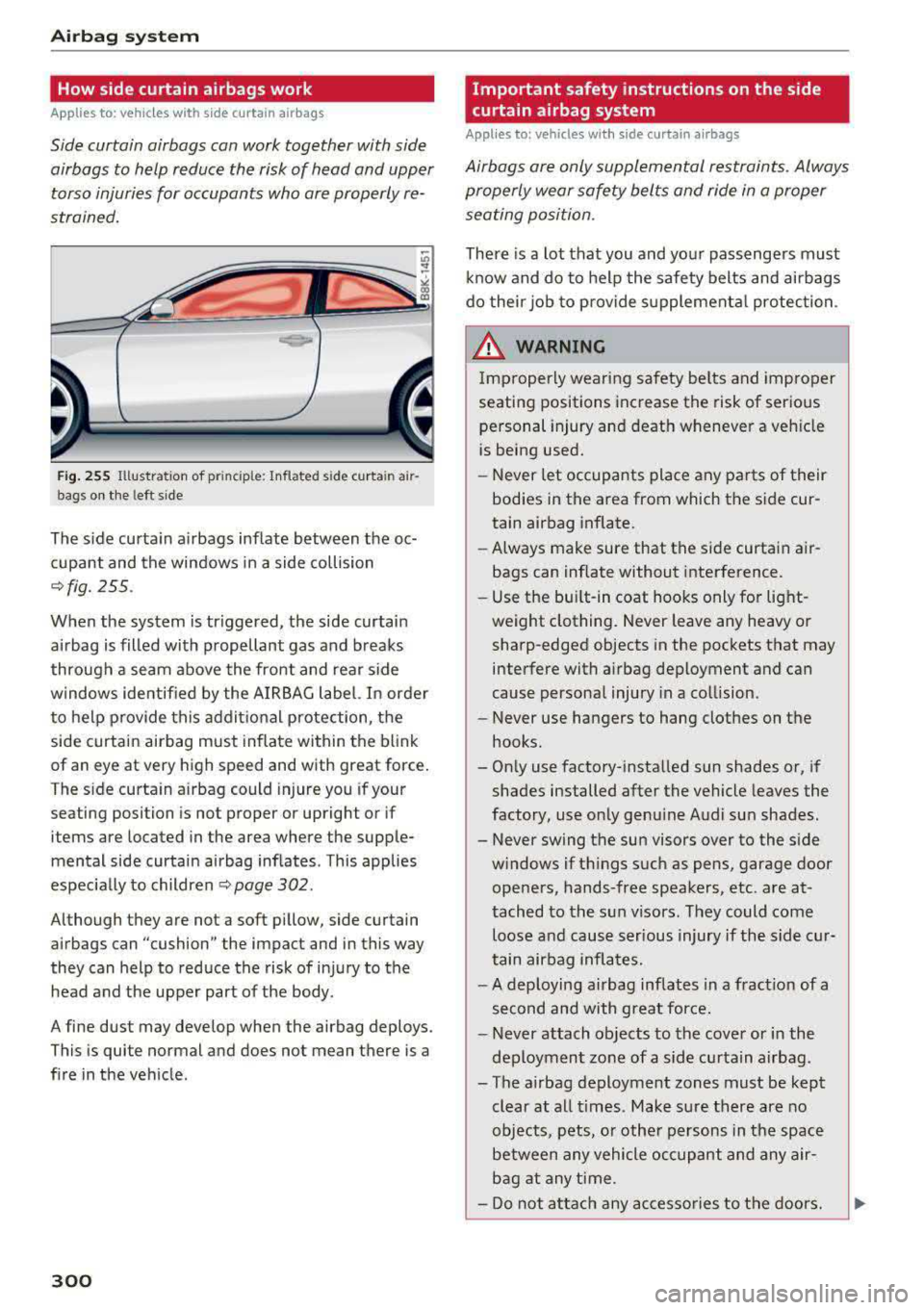
Airbag syste m
How side curtain airbags work
Applies to: ve hicles w ith s ide curta in a irbags
Side curtain airbags con work together with side
airbags to help reduce the risk of head and upper torso injuries for occupants who ore properly re
strained.
~ €
Fig . 255 Illustration of p rinc iple: Inflated s ide curta in air
bags on the left side
The s ide curtain airbags inflate between the oc
cupant and the windows in a side collision
¢ fig. 255 .
When the system is triggered, the side curtain
airbag is filled with propellant gas and breaks
through a seam above the front and rear side windows identified by the A IRBAG label. I n order
to help p rovide this addit ional protection, the
side curtain airbag must inflate within the blink
of an eye at very high speed and with great force .
The s ide curta in a irbag could injure you if your
seating position is not proper or upright or if
items are located in the area where the supple
mental side curtain airbag inflates . This applies
especially to
children ¢ page 302.
Although they are not a soft pillow, side curtain
airbags can "cushion" the impact and in this way
they can help to reduce the risk of injury to the
head and the upper part of the body .
A fine dust may develop when the airbag deploys.
This is quite normal and does not mean there is a
fire in the veh icle .
300
'
Important safety instructions on the side
curtain airbag system
Appl ies to : vehicles wi th side curtain airbags
Airbags ore only supplemental restraints . Always
properly wear safety belts and ride in a proper seating position .
There is a lot that you and your passengers must
know and do to help the safety belts and airbags
do their job to p rovide supplemental protection .
A WARNING
-Improperly wearing safety be lts and improper
seating positions increase the risk of serious
personal injury and death whenever a vehicle
is being used.
- Never let occupants place any parts of their
bodies in the area from which the side cur
tain airbag inflate.
- Always make sure that the side curtain air
bags can inflate without interference.
- Use the bu ilt-in coat hooks only for light
weight clothing. Never leave any heavy or
sharp-edged objects in the pockets that may
interfere with a irbag deployment and can
cause personal injury in a collision.
- Never use hangers to hang clothes on the
hooks.
- On ly use factory-installed sun shades or, if
shades installed after the vehicle leaves the
factory, use only genu ine Audi sun shades.
- Never swing the sun visors over to the s ide
w indows if things such as pens, garage door
openers, hands-free speakers, etc . are at
tached to the sun v isors. They could come
loose and cause serious injury if the side cu r
tain airbag infla tes.
- A deploying airbag inflates in a fract ion of a
second and with great force.
- Never attach objects to the cover or in the
deployment zone of a s ide curtain airbag .
- The airbag deployment zones must be kept clear at al l t imes. Make sure there are no
objects, pets, o r othe r persons in the space
between any vehicle occupant and any air
bag at any time .
- Do not attach any accessories to the doors.
Page 302 of 409
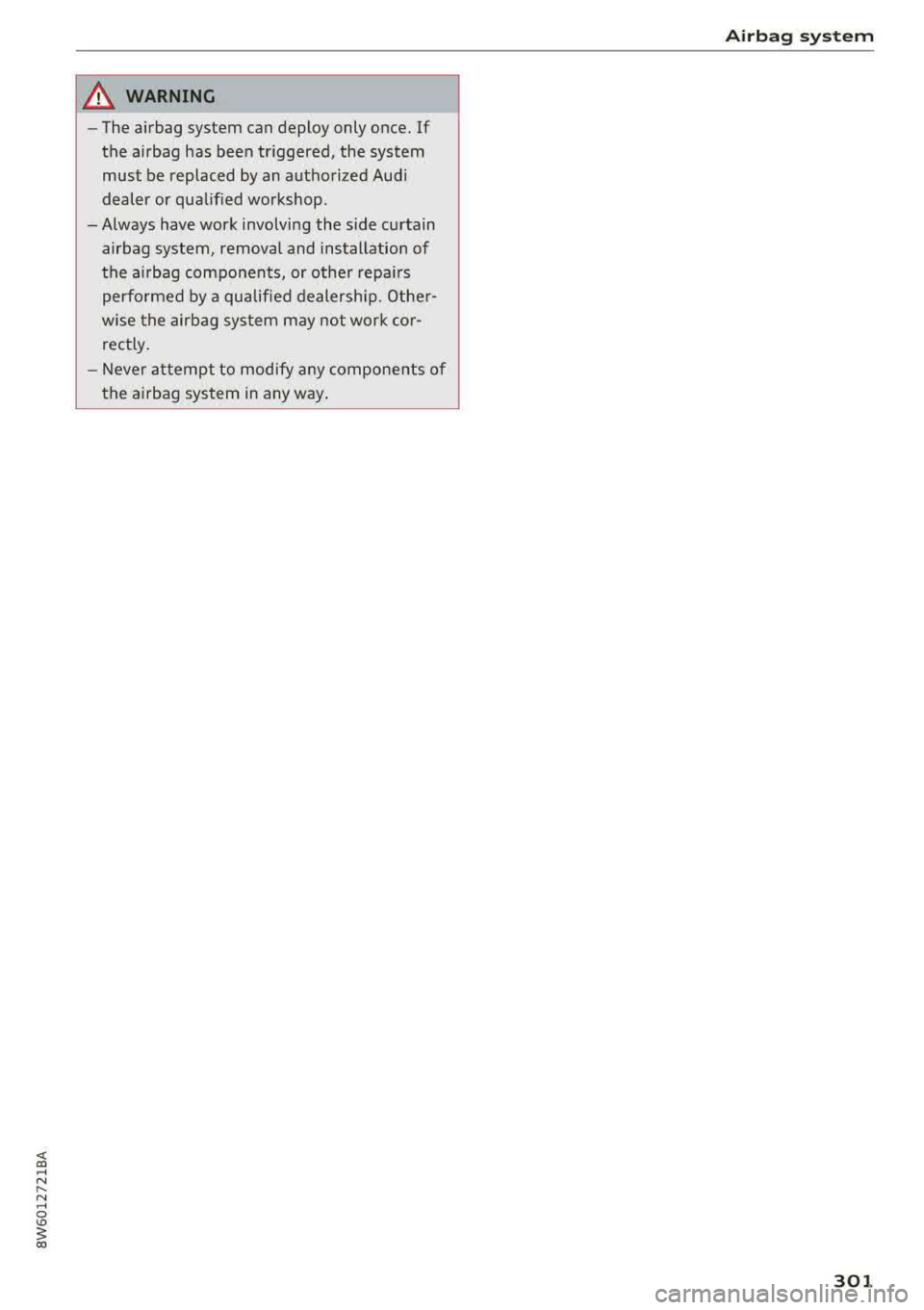
<( a, .... N ,....
N .... 0 \0
3 a,
A WARNING ,~
- The airbag system can deploy only once. If
the a irbag has been tr iggered, the system
must be replaced by an authorized Aud i
dealer or qualified workshop .
-Always have work involving the side curtain airbag system, removal and installation of
the a irbag components, or other repa irs
perfo rmed by a qualified dealersh ip. Othe r
wise the airbag system may not wor k co r
rectly .
- Never attempt to modify any components of
the a irbag system in any way .
Airbag sys tem
301
Page 303 of 409
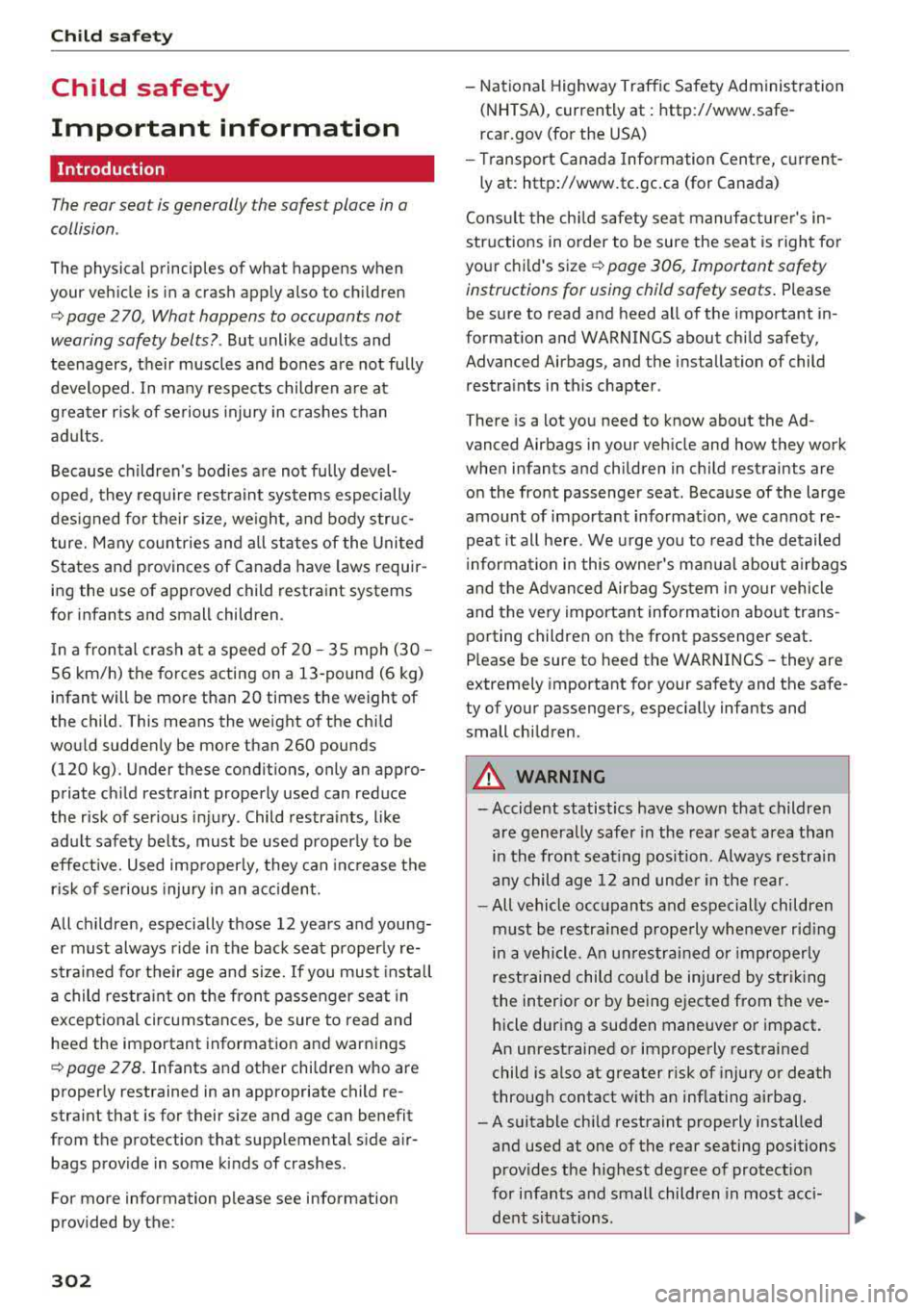
Child safety
Child safety
Important information
Introduction
The rear seat is generally the safest place in a
collision .
The physical principles of what happens when
your vehicle is in a crash apply also to children
¢ page 2 70, What happens to occupants not
wearing safety belts? .
But unlike adults and
teenagers, their muscles and bones are not fully
developed. In many respects children are at
greater risk of serious injury in crashes than
adults .
Because children's bodies are not fully devel
oped, they require restraint systems especially
designed for their size, weight, and body struc
ture. Many countries and all states of the United
States and provinces of Canada have laws requir
ing the use of approved child restraint systems
for infants and small children .
In a frontal crash at a speed of 20 -3 5 mph (30 -
S6 km/h) the forces acting on a 13-pound (6 kg)
infant will be more than 20 times the weight of
the child. This means the weight of the child
would suddenly be more than 260 pounds
(120 kg) . Under these conditions, only an appro
priate child restraint properly used can reduce
the risk of serious injury . Child restraints, like
adult safety belts, must be used properly to be
effective. Used improperly, they can increase the
risk of serious injury in an accident.
All children, especially those 12 years and young
er must always ride in the back seat properly re
strained for their age and size. If you must install
a child restraint on the front passenger seat in
exceptional circumstances, be sure to read and
heed the important information and warnings
¢ page 2 78. Infants and other children who are
properly restrained in an appropriate child re
straint that is for their si ze and age can benefit
from the protection that supplemental side air
bags provide in some kinds of crashes .
For more information please see information
provided by the:
302
-National Highway Traffic Safety Administration
(NHTSA), currently at: http :/ /www.safe
rcar.gov (for the USA)
-Transport Canada Information Centre, current-
ly at: http://www.tc.gc.ca (for Canada)
Consult the child safety seat manufacturer's in
structions in order to be sure the seat is right for
your child's
size ¢ page 306, Important safety
instructions for using child safety seats.
Please
be sure to read and heed all of the important in
formation and WARNINGS about child safety,
Advanced Airbags, and the installation of child
restraints in this chapter .
There is a lot you need to know about the Ad
vanced Airbags in your vehicle and how they work
when infants and children in child restraints are
on the front passenger seat. Because of the large
amount of important information, we cannot re
peat it all here. We urge you to read the detailed
information in this owner's manual about airbags
and the Advanced Airbag System in your vehicle
and the very important information about trans
porting children on the front passenger seat.
Please be sure to heed the WARNINGS
-they are
extremely important for your safety and the safe
ty of your passengers, especially infants and
small children .
A WARNING
-Accident statistics have shown that children
are generally safer in the rear seat area than
in the front seating position. Always restrain
any child age 12 and under in the rear.
-All vehicle occupants and especially children
must be restrained properly whenever riding
in a vehicle. An unrestrained or improperly
restrained child could be injured by striking
the interior or by being ejected from the ve
hicle during a sudden maneuver or impact.
An unrestrained or improperly restrained
child is also at greater risk of injury or death
through contact with an inflating airbag.
-A suitable child restraint properly installed and used at one of the rear seating positions
provides the highest degree of protection
for infants and small children in most acci
dent situations.
Page 304 of 409
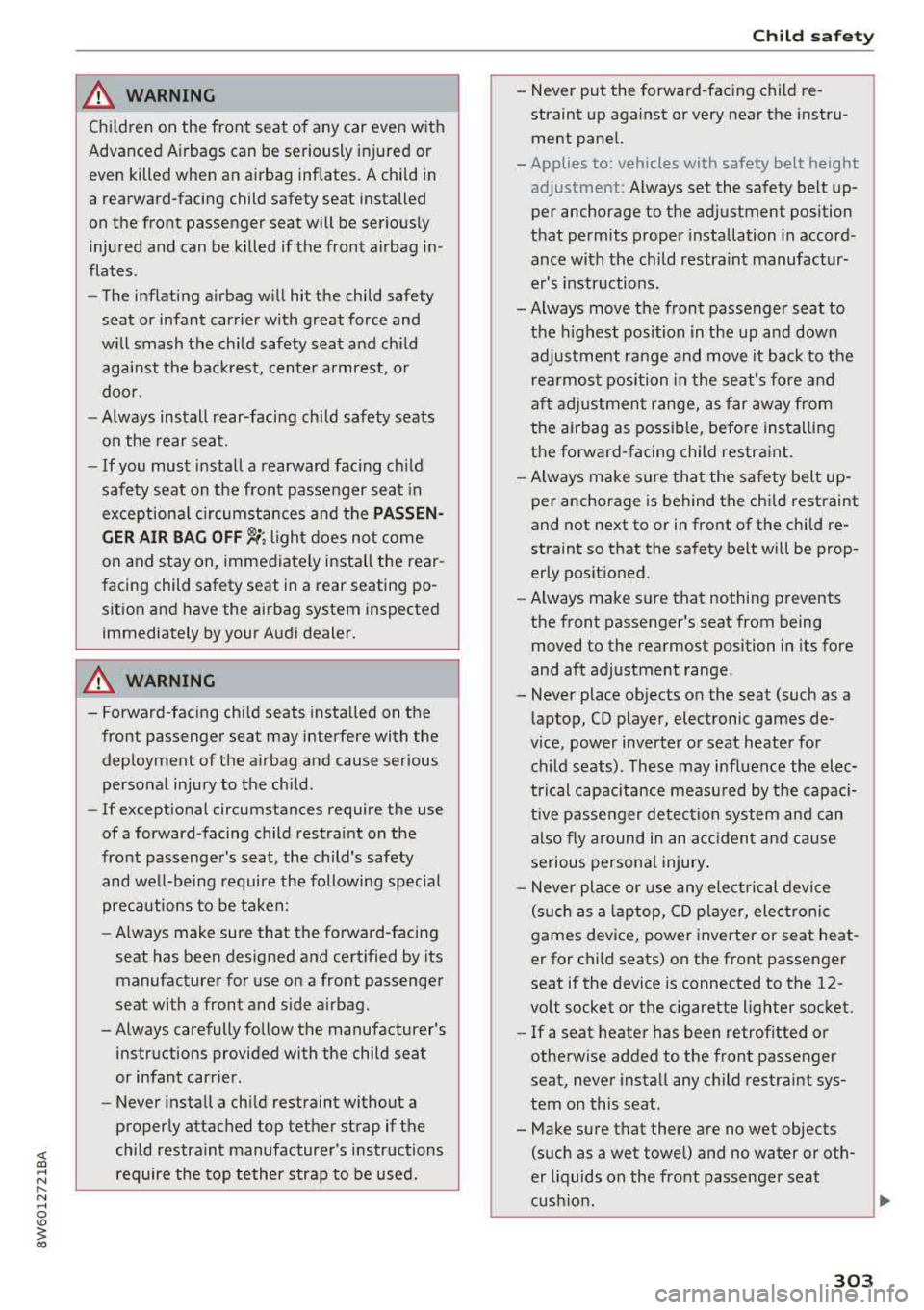
<( a, .... N ,....
N .... 0 \0
3 a,
A WARNING
Child ren on the front seat of any car even w ith
Advanced Airbags can be seriously injured or
even killed when an airbag inflates. A child in
a rearward-facing child safety seat installed
on the front passenger seat will be seriously
injured and can be killed if the front airbag in
flates.
- The inflating airbag will hit the child safety
seat or infant carrier with great force and
will smash the ch ild safety seat and child
against the backrest, center armrest, or
door.
- Always install rear-facing child safety seats
on the rear seat.
- If you must install a rearward fac ing ch ild
safety seat on the front passenger seat in
exceptiona l circumstances and the
PA SSEN
GE R AIR BAG OFF
,;; light does not come
on and stay on, immediately install the rear
facing child safety seat in a rear seating po sition and have the airbag system inspected
immediately by your Audi dealer.
A WARNING
- Forward-facing chi ld seats installed on the
front passenger seat may interfere with the deployment of the a irbag and cause serious
personal injury to the child.
- If except ional circumstances require the use
of a forward-facing child restraint on the
front passenger's seat, the child's safety and well-being require the following special
precautions to be taken:
- Always make sure that the fo rward-facing
seat has been designed and certified by its manufacturer for use on a front passenger
seat with a front and s ide a irbag.
- Always carefully follow the manufacturer's instructions provided with the child seat
or infant carrier.
- Never install a chi ld restraint without a
properly attached top tether strap if the
child restraint manufacturer's instructions require the top tether strap to be used.
Ch ild safety
-Never put the forward-facing child re
straint up against or very near the instru
ment panel.
- Applies to: vehicles with safety be lt height
adjustment: Always set the safety belt up
per anchorage to the adjustment pos ition
that permits proper installation in accord
ance with the child restraint manufactur
er's instructions.
- Always move the front passenger seat to the h ighest position in the up and down
adjustment range and move it back to the
rearmos t position in the seat's fore and
a ft ad justment range, as far away from
the a irbag as poss ible, before installing
the forward-facing child restraint .
- Always make sure that the safety belt up
per anchorage is behind the chi ld restraint
and not next to or in front of the child re
straint so that the safety belt will be prop
erly pos it ioned.
- Always make sure that nothing prevents
the front passenger's seat from being
moved to the rearmost position in its fore
and aft adjustment range.
- Never place objects on the seat (such as a
laptop, CO player, electronic games de
vice, power inverter or seat heater fo r
ch ild seats) . These may influence the elec
trical capacitance measu red by the capac i
tive passenger detec tion system and can
also fly around in an acc iden t and c ause
serious personal injury .
- Never place or use any ele ct rical devi ce
(such as a laptop, CO player, electroni c
games device, powe r inverter or seat heat
er for child seats) on the front passenger
seat if the device is connected to the
12-
vo lt socket or the cigarette lighter socket.
- If a seat heater has been retrofitted or
otherw ise added to the front passenger
seat, never insta ll any child restraint sys
tem on this seat.
- Make su re that there are no wet objects
(such as a wet towe l) and no water or oth
er liquids on the front passenger seat
cush ion.
303
Page 305 of 409
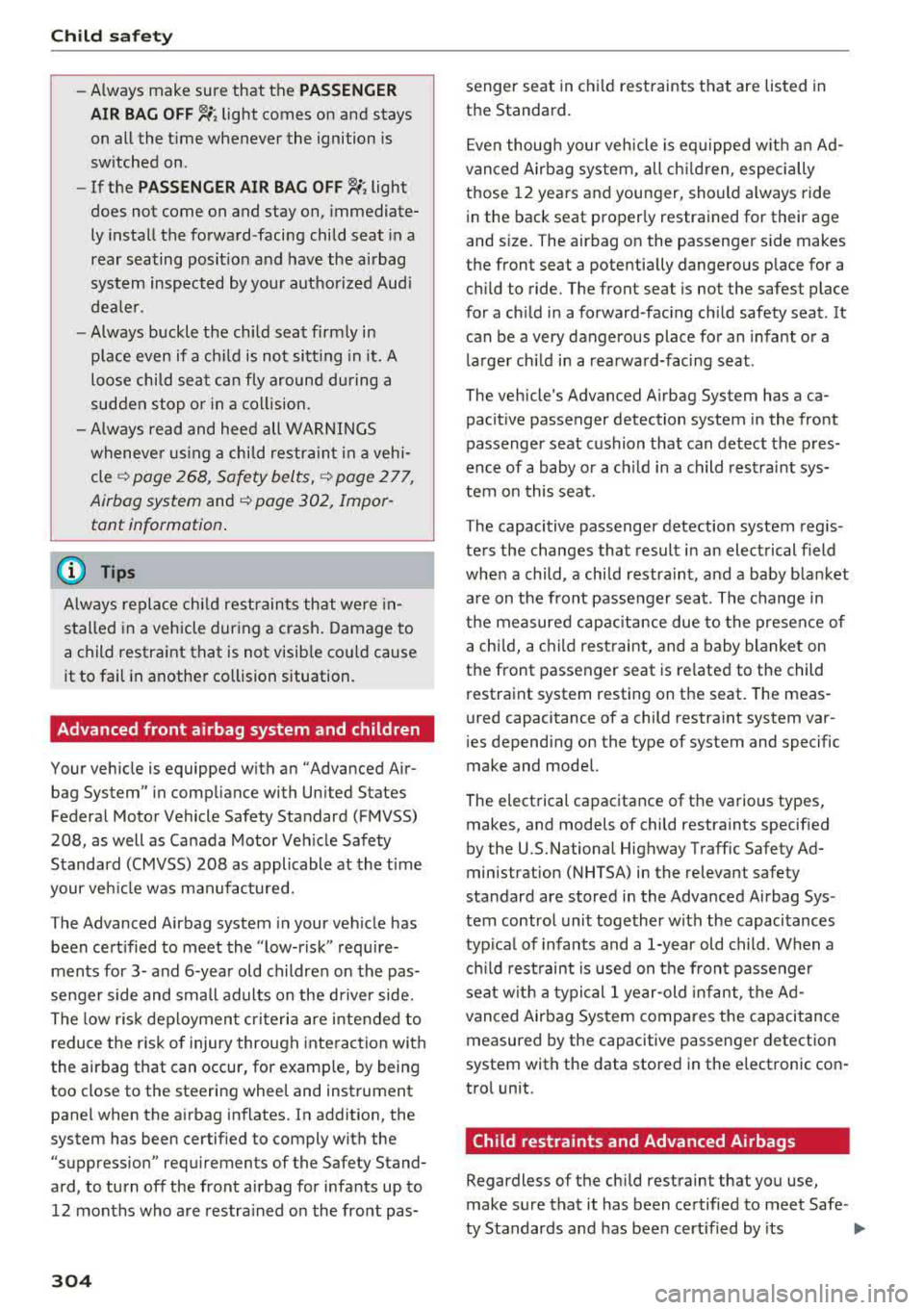
Child safety
-Always make sure that the PASSENGER
AIR BAG
OFF~; light comes on and stays
on all the time whenever the ignition is
switched on .
- If the
PASSENGER AIR BAG OFF~; light
does not come on and stay on, immediate
ly install the forward-facing child seat in a
rear seating position and have the airbag
system inspected by your authorized Audi
dealer.
- Always buckle the child seat firmly in
place even if a child is not sitting in it. A
loose child seat can fly around during a
sudden stop or in a collision.
-Always read and heed all WARNINGS
whenever using a child restraint in a vehi
cle ¢
page 268, Safety belts , ~ page 2 77,
Airbag system and ~ page 302, Impor
tant information.
(D Tips
Always replace child restraints that were in
stalled in a vehicle during a crash. Damage to
a child restraint that is not visible could cause
it to fail in another collision situation.
Advanced front airbag system and children
Your vehicle is equipped with an "Advanced Air
bag System" in compliance with United St ates
Federal Motor Vehicle Safety Standard (FMVSS)
208, as well as Canada Motor Vehicle Safety
Standard (CMVSS) 208 as applicable at the time
your vehicle was manufactured.
The Advanced Airbag system in your vehicle has
been certified to meet the "low-risk " require
ments for 3- and 6-year old children on the pas
senger side and small adults on the driver side.
The low risk deployment criteria are intended to
reduce the risk of injury through interaction with
the airbag that can occur, for example, by being
too close to the steering wheel and instrument
panel when the airbag inflates. In addition, the
system has been certified to comply with the
"suppression" requirements of the Safety Stand
ard, to turn off the front airbag for infants up to 12 months who are restrained on the front pas-
304
senger seat in child restraints that are listed in
the Standard.
Even though your vehicle is equipped with an Ad
vanced Airbag system, all children, especially
those 12 years and younger, should always ride
in the back seat properly restrained for their age
and size. The airbag on the passenger side makes
the front seat a potentially dangerous place for a child to ride. The front seat is not the safest place
for a child in a forward-facing child safety seat. It
can be a very dangerous place for an infant or a
larger child in a rearward-facing seat.
The vehicle's Advanced Airbag System has a ca pacitive passenger detection system in the front
passenger seat cushion that can detect the pres
ence of a baby or a child in a child restraint sys
tem on this seat.
The capacitive passenger detection system regis
ters the changes that result in an electrical field
when a child, a child restraint , and a baby blanket
are on the front passenger seat. The change in
the measured capacitance due to the presence of
a child, a child restraint, and a baby blanket on
the front passenger seat is related to the child
restraint system resting on the seat. The meas
ured capacitance of a child restraint system var
ies depending on the type of system and specific
make and model.
The electrical capacitance of the various types, makes, and models of child restraints specified
by the U.S.National Highway Traffic Safety Ad
ministration (NHTSA) in the relevant safety
standard are stored in the Advanced Airbag Sys
tem control unit together with the capacitances
typical of infants and a 1-year old child. When a
child restraint is used on the front passenger
seat with a typical 1 year-old infant, the Ad
vanced Airbag System compares the capacitance
measured by the capacitive passenger detection
system with the data stored in the electronic con
trol unit .
Child restraints and Advanced Airbags
Regardless of the child restraint that you use,
make sure that it has been certified to meet Safe -
ty Standards and has been certified by its
..,.
Page 306 of 409
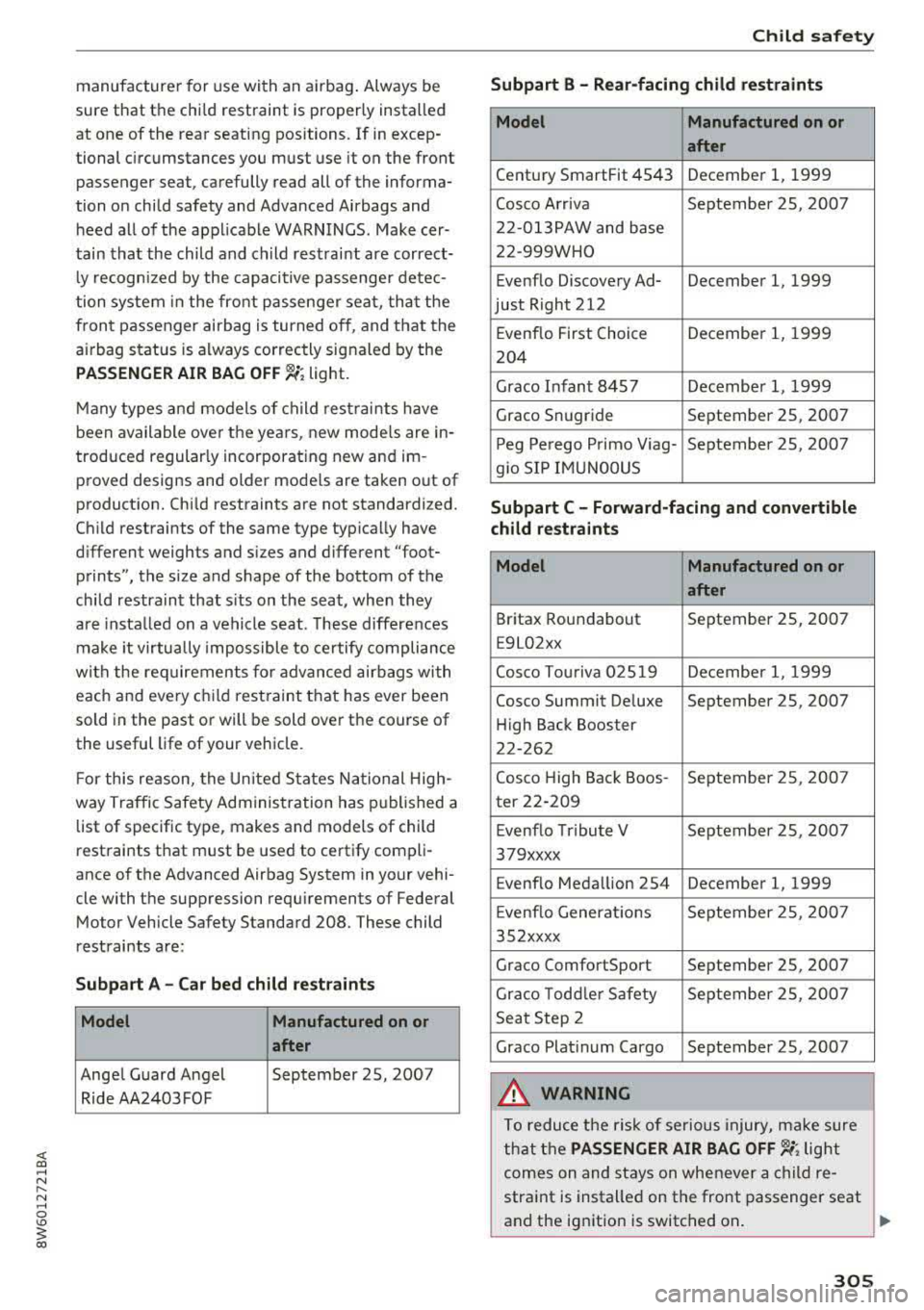
<( a, .... N ,....
N .... 0 \0
3 a,
manufacturer for use with an airbag. Always be
sure that the child restraint is properly installed
at one of the rear seating positions . If in excep
tional circumstances you must use it on the front
passenger seat, carefully read all of the informa
tion on child safety and Advanced Airbags and heed all of the appl icable WARNINGS . Make cer
tain that the child and ch ild restraint are correct
ly recognized by the capacitive passenger detec
tion system in the front passenger seat, that the
front passenger airbag is turned off, and that the
airbag status is always correctly signaled by the
PASSENGER A IR BAG OFF 1,;; light.
Many types and models of ch ild rest rai nts have
been available over the yea rs, new mode ls are in
troduced regularly incorporating new and im
proved designs and older mode ls are taken out of
product ion. Chi ld restraints are not standardized.
Ch ild restraints of the same type typically have
d ifferent weights and sizes and different "foot
prints", the s ize and shape of the bottom of the
chi ld restraint that sits on the seat, when they
are insta lled on a vehicle seat. These differences
make it virtually impossible to certify compliance
with the req uirements fo r advanced airbags wi th
each and every child restraint that has ever been
sold in the past or will be sold over the course of
the useful life of your vehicle.
F or this reason, the Un ited States National High
way Traffic Safety Administration has published a
list of specific type, makes and models of child
restraints that must be used to certify compli
ance of the Advanced Airbag System in your vehi
cle with the suppression requ irements of Federal
Motor Vehicle Safety Standard 208 . These child
restraints are:
Subp art A - Car bed child re stra int s
Model Manufactured on or
after
Ange l Guard Angel September 25, 2007
Ride AA2403FOF
Ch ild safety
Subpart B - R ear -facing child restraints
Model Manufactured on or
after
Century SmartFit 4543 December 1, 1999
Cosco Arriva September 25, 2007
22-013PAW and base
22-999WHO
Evenflo Discovery Ad- December 1, 1999
just Right 212
Evenflo First Choice December 1, 1999
204
Graco Infant 8457 Decembe r 1, 1999
Graco Snugride September 25, 2007
P eg Pe rego P rimo Viag- September 25, 2007
g io SIP IMUNOOUS
Subpart C - Forward -facing and convertible
child restraints
Model Manufactured on or
after
Britax Roundabout September 25, 2007
E9L02xx
Cosco Tou riva 025 19 Decembe r 1, 1999
Cosco Summit De luxe September 25, 2007
H igh Back Booster
22-262
Cosco High Back Boos -September 25, 2007
ter 22-209
E venflo Tribute V September 25, 2007
379xxxx
Evenflo Medallion 254 December 1, 1999
E venflo Generat io ns September 25, 2007
352xxxx
Graco ComfortSport September 25, 2007
Graco Todd le r Safety September 25, 200 7
Seat Step 2
Graco Platinum Cargo September 25, 2007
A WARNING
To reduce the risk of serious injury, ma ke sure
that the
PASSENGER AIR BAG OFF 1,;; light
comes on and stays on whenever a child re
straint is installed on the front passenger seat
and the ignition is switched on .
..,.
305
Page 307 of 409
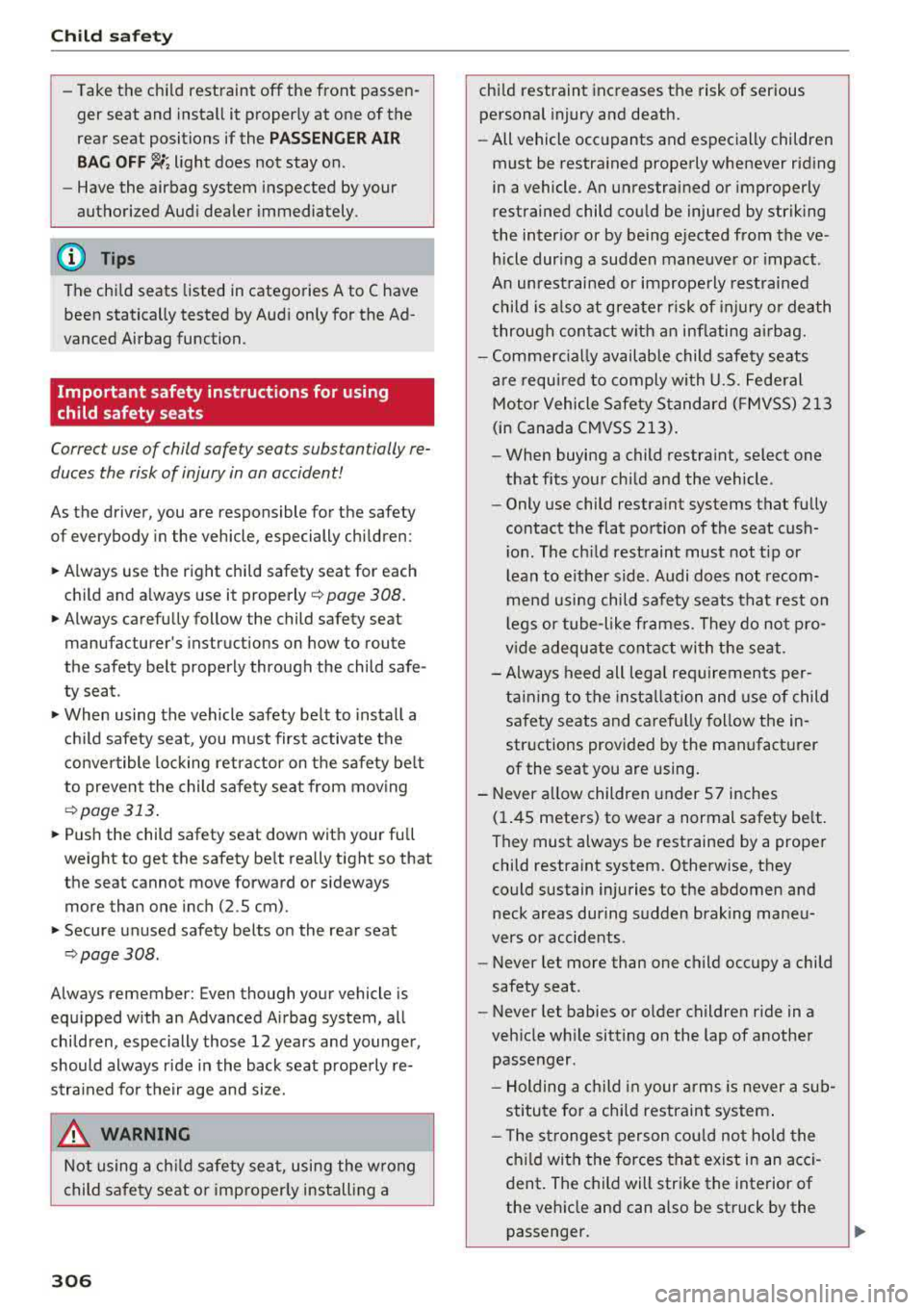
Child safety
-Take the child restraint off the front passen
ger seat and install it properly at one of the
rear seat positions if the
PASSENGER AIR
BAG
OFF~; light does not stay on .
- Have the airbag system inspected by your
authorized Audi dealer immediately.
(D Tips
The child seats listed in categories A to C have
been statically tested by Audi only for the Ad
vanced Airbag function.
Important safety instructions for using
child safety seats
Correct use of child safety seats substantially re
duces the risk of injury in an accident!
As the driver, you are responsible for the safety
of everybody in the vehicle, especially children:
.,. Always use the right child safety seat for each
child and always use it properly
c::> page 308.
.,. Always carefully follow the child safety seat
manufacturer's instructions on how to route
the safety belt properly through the child safe
ty seat .
.,. When using the vehicle safety belt to install a
child safety seat , you must first activate the
convertible locking retractor on the safety belt
to prevent the child safety seat from moving
c::>page 313.
.,. Push the child safety seat down with your full
weight to get the safety belt really tight so that
the seat cannot move forward or sideways
more than one inch (2.5 cm).
.,. Secure unused safety belts on the rear seat
c::> page 308 .
Always remember: Even though your vehicle is
equipped with an Advanced Airbag system, all
children, especially those 12 years and younger,
should always ride in the back seat properly re
strained for their age and size.
_& WARNING
Not using a child safety seat, using the wrong
child safety seat or improperly installing a
306
child restraint increases the risk of serious
personal injury and death.
- All vehicle occupants and especially children
must be restrained properly whenever riding
in a vehicle. An unrestrained or improperly
restrained child could be injured by striking
the interior or by being ejected from the ve
hicle during a sudden maneuver or impact .
An unrestrained or improperly restrained
child is also at greater risk of injury or death
through contact with an inflating airbag.
- Commercially available child safety seats
are required to comply with U.S. Federal
Motor Vehicle Safety Standard (FMVSS) 213
(in Canada CMVSS 213).
- When buying a child restraint, select one
that fits your child and the vehicle .
- Only use child restraint systems that fully
contact the flat portion of the seat cush ion. The child restraint must not tip or
lean to either side . Audi does not recom
mend using child safety seats that rest on
legs or tube-like frames. They do not pro
vide adequate contact with the seat.
- Always heed all legal requirements per
taining to the installation and use of child
safety seats and carefully follow the in
structions provided by the manufacturer
of the seat you are using.
- Never allow children under 57 inches
(1.45 meters) to wear a normal safety belt .
They must always be restrained by a proper
child restraint system. Otherwise, they
could sustain injuries to the abdomen and
neck areas during sudden braking maneu
vers or accidents .
- Never let more than one child occupy a child
safety seat.
- Never let babies or older children ride in a
vehicle while sitting on the lap of another
passenger .
- Holding a child in your arms is never a sub
stitute for a child restraint system.
- The strongest person could not hold the
child with the forces that exist in an acci
dent. The child will strike the interior of
the vehicle and can also be struck by the
passenger.
Page 308 of 409
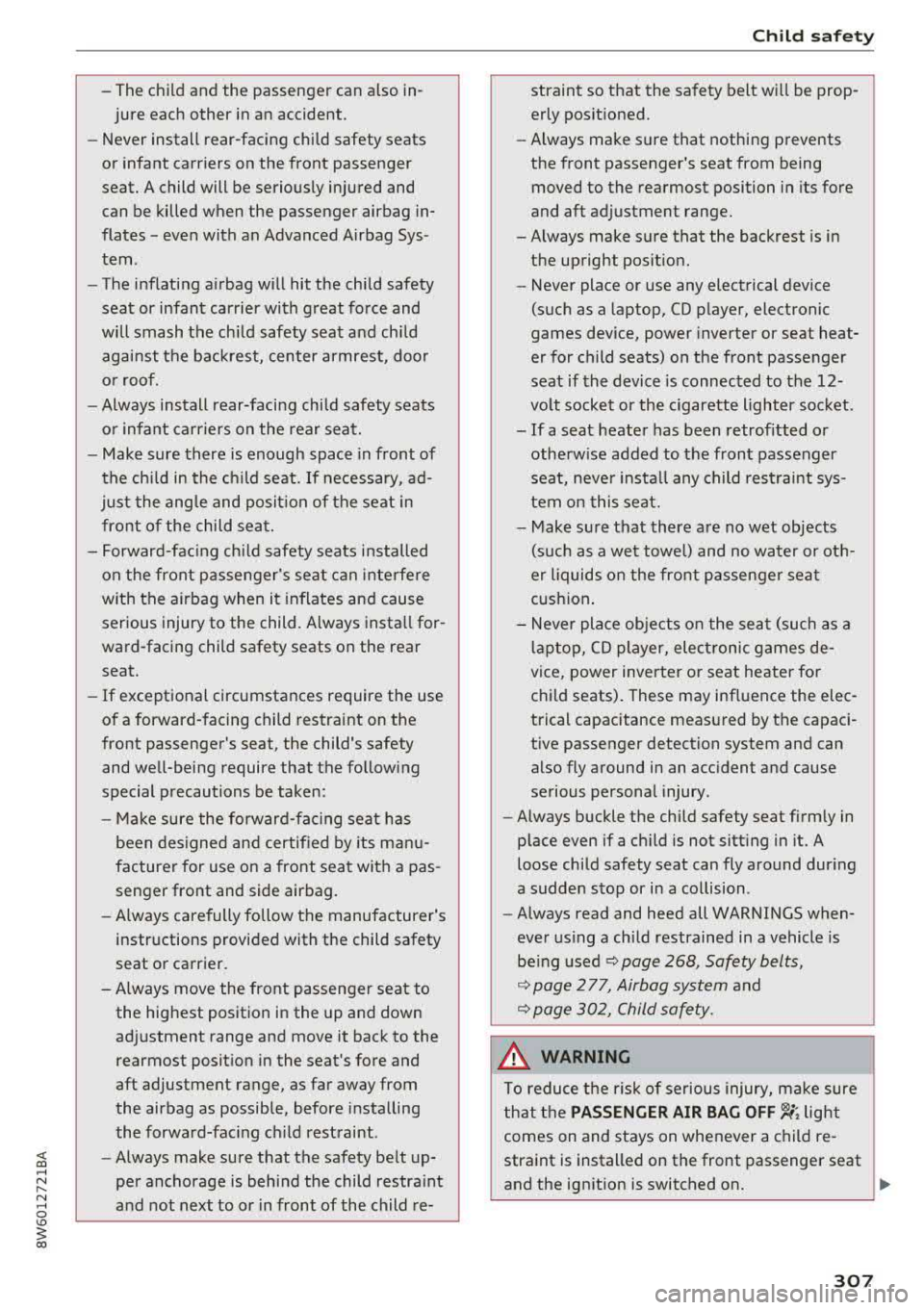
<( a, .... N ,....
N .... 0 \0
3 a,
-The child and the passenger can also in
jure each other in an accident.
- Never install rear-facing chi ld safety seats
or infant carriers on the front passenger
seat. A child will be serious ly injured and
can be killed when the passenger airbag in
flates - even with an Advanced Airbag Sys
tem.
- The inflating a irbag will hit the child safety
seat or infant carrier with great force and
will smash the ch ild safety seat and chi ld
against the backrest, center armrest, door
o r roof.
- Always install rear-facing child safety seats
o r infant carriers on the rear seat.
- Make sure there is enough space in front of
the ch ild in the child seat. If necessary, ad
just the ang le and posit ion of the seat in
front of the child sea t.
- Forward-fac ing ch ild safety seats installed
on the front passenger's seat can inte rfe re
with the airbag when it inflates and cause
serious injury to the child . Always insta ll for
ward-facing child safety seats on
the rear
seat.
- If exceptional circumstances require the use
of a forward-facing child restraint on the
front passenger's seat, the child's safety and well-being require that the following
special precautions be taken:
- Make sure the forward-fa cing seat h as
been designed and certif ied by its manu
facturer for use on a front seat with a pas
senger front and side airbag.
- Always care fully follow the manufacturer's
instr uctions provided with the child safety
seat or carrier.
- Always move the front passenger seat to the highest position in the up and down
ad justment range and move it back to the
rearmost posit ion in the seat's fore and
aft adjustment range, as far away from
the airbag as possible, before installing
the forward-fac ing ch ild restraint.
- Always make sure that the safety be lt up
per anchorage is behind the child restra int
and not next to or in front of the child
r e-
Ch ild safety
straint so that the safety belt wi ll be prop
erly pos it ioned.
- Always make sure that nothing prevents
the front passenger's seat from being moved to the rearmost position in its fore
and aft adjustment range.
- Always make sure that the backrest is in the upright posit ion.
- Never place or use any elect rical device
(such as a laptop, CD player, electronic
games device, power inverter or seat heat
er for child seats) on the front passenger
seat if the device is connected to the
12-
vo lt socket or the cigarette lighter soc ket.
- If a seat heater has been retrofitted or othe rw ise added to t he fron t passenger
seat, neve r insta ll any child rest raint sys
tem on this seat.
- Make su re that there a re no wet objects
(such as a wet towe l) and no water or oth
er liquids on the front passenger sea t
cush ion .
- Neve r place objects o n the sea t (such as a
laptop, CD player, e lect ronic games de
vice, power inverter or seat heater for
child seats). These may inf luence the elec
trical capacitance meas ured by t he capaci
tive passenger detection system and can also fly around in an acc ident and cause
serious personal injury.
- Always buckle the child safety seat firmly in
p lace even if a ch ild is not sitt ing in it. A
loose child safety seat can fly around dur ing
a sudde n stop or i n a co llision .
- Always read and heed all WARNINGS when
ever us ing a child restrained in a vehicle is
be ing
u sed~ page 268, Safety belts,
<=> page 2 77, Airbag system and
<=> page 302, Child safe ty.
_&. WARNING
To reduce the risk of serious injury, ma ke sure
t hat the
PASSENGER AIR BAG OFF '1; light
comes on and stays on whenever a child re
straint is installed on the front passenger seat
and the ign it ion is switched on.
..,
307
Page 309 of 409
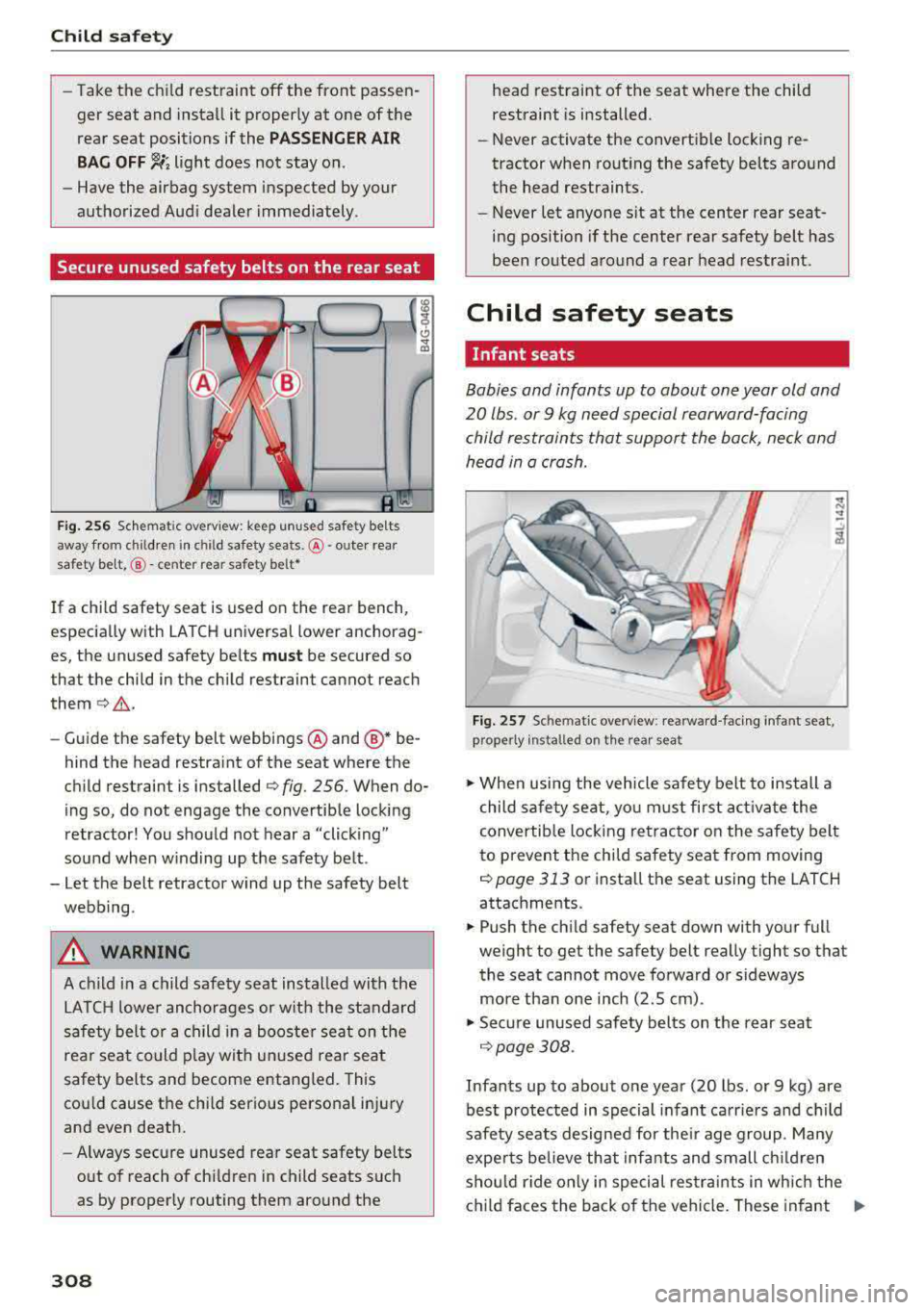
Child safety
-Take the child restraint off the front passenger seat and install it proper ly at one of the
rear seat positions if the
PASSEN GER AIR
BA G
OFF~; light does not stay on.
-Have the airbag system inspected by your
authorized Aud i dealer immediately.
Secure unused safety belts on the rear seat
l8
,h- --lJ ;g
---0
Fig . 256 Schematic overv iew: keep unused safety be lts
away from chi ld ren i n chil d safety
seats. @-oute r rear
safety belt, @ - center rear safety be lt*
~
If a chi ld safety seat is used on the rear bench,
especially with LA TCH universal lower anchorag
es, the unused safety be lts
mu st be secured so
that the child in the child restraint cannot reach
them¢,& .
-Gu ide the safety belt webbings @and ®* be
hind the head restraint of the seat where the
child restraint is installed
¢fig. 256. When do
ing so, do not engage the convertible locking
retractor! You should not hear a "click ing"
sound when w inding up the safety be lt .
-Let the belt retractor wind up the safety belt
webb ing .
_& WARNING
A ch ild in a child safety seat installed with the
LATC H lower anchorages or w ith the standard
safety belt or a child in a booste r seat on the
rear seat could p lay with unused rear seat
safety belts and become entangled. This
cou ld cause t he chi ld ser ious personal injury
and even death.
-Always sec ure unused rear seat safety belts
o ut of reach of ch ild ren in child seats such
as by proper ly routing them around the
308 head restraint of the seat where the child
restraint is installed .
-Never activate the convertible locking re
tractor when routing the safety belts around
the head restraints.
-Never let anyone s it at the center rear seat
ing position if the center rear safety belt has
been routed around a rear head restraint.
Child safety seats
Infant seats
Babies and infants up to about one year old and
20 lbs . or
9 kg need special rearward-facing
child restraints that support the back, neck and
head in a crash.
Fig. 257 Sc hema tic ove rview : rearward -facing infa nt sea t,
prope rly installed on th e rear sea t
.. When using the veh icle safe ty belt to install a
child safe ty seat, yo u must first a ct ivate the
convertib le locking re tractor on the safe ty belt
to prevent the child safety seat from moving
r::!>poge 313 or insta ll the seat using the LATCH
attachments .
.. Push the child safety seat down with your full
weight to get the safety belt really tight so that
the seat cannot move forward or sideways
more than one inch (2 .5 cm).
.. Secure unused safety bel ts on the rear seat
c:!> page 308 .
Infants up to about one year (20 lbs . or 9 kg) are
best protected in special infant carr iers and child
safe ty seats designed for the ir age group. Many
expe rts be lieve that infa nts and small ch ildren
shou ld r ide o nly in special res tra ints in wh ich the
ch ild faces the back of the vehicle. These infant
II>
Page 310 of 409
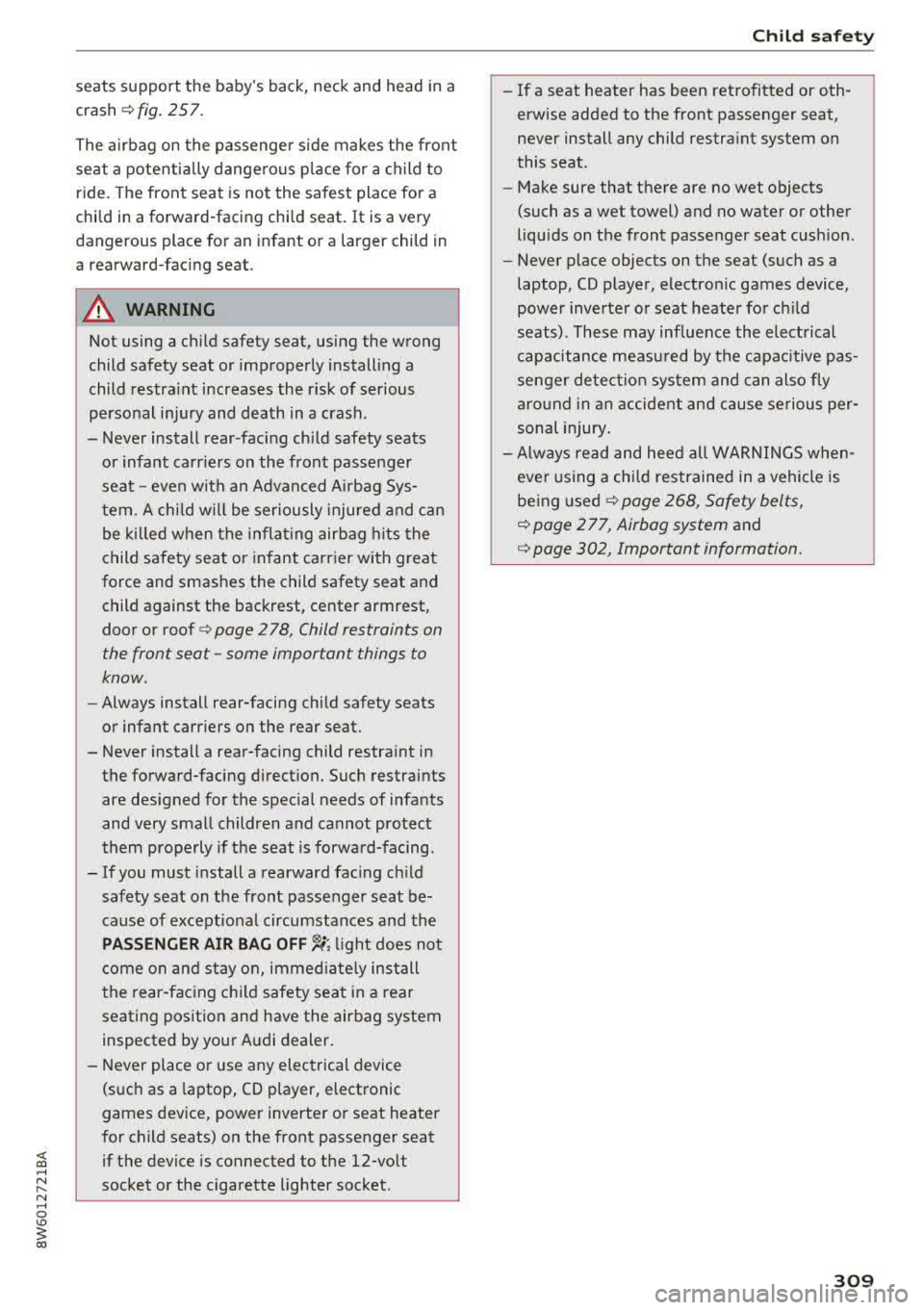
<( a, .... N ,....
N .... 0 \0
3 a,
seats support the baby 's back, neck and head in a
crash
¢ fig . 257.
The a irbag on the passenger side makes the front
seat a potentia lly dangerous p lace for a child to
ride . The front seat is not the safest place for a
child in a forward-facing chi ld seat. It is a very
dangerous place for an infant or a larger child in
a rearward-facing seat .
A WARNING
Not using a child safety seat, using the wrong
child safety seat or improperly installing a
child restra int increases the r isk of serious
personal injury and death in a crash .
- Never install rear -facing child safety seats
or infant carriers on the front passenger
seat -even with an Advanced Airbag Sys
tem . A chi ld w ill be seriously injured and can
be k illed when the inflat ing airbag hits the
child safety seat or infant carrier with great
force and smashes the child safety seat and
child against the backrest, center armrest
'
door or roof c> page 2 78, Child restraints on
the front seat -some important things to
know .
-Always install rear-facing child safety seats
or infant carriers on the rear seat.
- Never install a rear-facing child restraint in the forward-facing direct ion. Such restraints
are designed for the spec ial needs of infants
and very small children and cannot protect
them properly if the seat is forward-facing .
- If you must install a rearward fac ing ch ild
safety seat on the front passenger seat be
cause of exceptiona l circumstances and the
PAS SENGER AIR BAG OFF ~; light does not
c ome on and stay on, immed iate ly install
the rear-fac ing child safety seat in a rear
seating position and have the airbag system
inspected by your Audi dealer.
- Never place or use any electrical device (such as a laptop, CD player, electronic
games dev ice, power inverter or seat heater
for child seats) on the front passenger seat
if the device is connected to the 12-volt
socket or the cigarette lighter socket .
Child safety
-If a seat heater has been retrofitted or oth
erwise added to the front passenger seat,
never install any child restra int system on
this seat .
- Make sure that there are no wet objects
(such as a wet towel) and no water or other
liquids on the front passenger seat cush ion.
- Never place objects on the seat (such as a
laptop, CD p layer, electronic games device,
power inverter o r seat heater fo r ch ild
seats) . These may influence the elect rical
capacitance measu red by the capacitive pas
senger de tect io n system and can also fly
aro und in an accident and cause serious per
sonal injury .
- Always read and heed all WARNINGS when
ever using a child restrained in a vehicle is
be ing used
¢ page 268, Safety belts,
c::!;> poge 277, Airbag system and
c::!;> page 302, Important information.
309